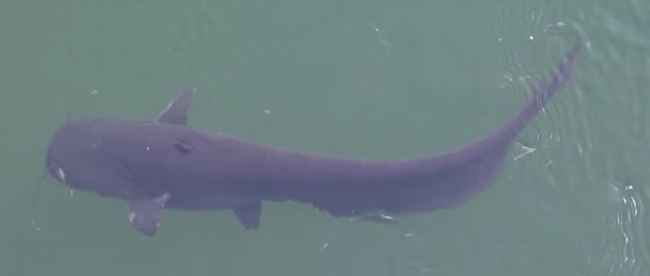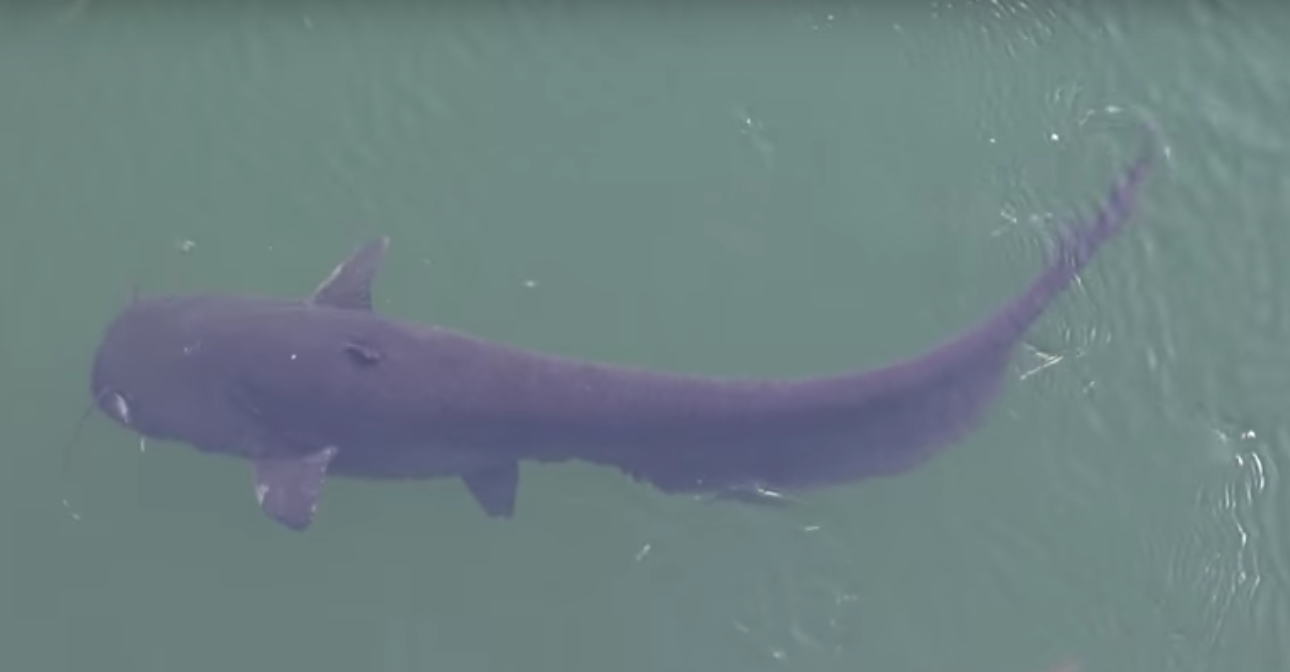A Fishy Story

In 1986, the Soviet Union was struck by disaster as the core of the Chernobyl nuclear power plant exploded. The surrounding areas became unsafe for humans due to the radioactive contamination, and officials created the “Chernobyl Exclusion Zone,” what is now a 1,000 square mile (2,600 km^2) area where, per Wikipedia, “fallout is highest.” With rare exception, people have been barred from the Zone since — the perils of prolonged exposure to areas of high radiation aren’t well known, but they are probably best avoided. As a result, for the last thirty years, few humans have been in the area.
But animals? They’re harder to keep out. And sometimes, this happens.

That looks like a little shark, maybe — but it’s not. Even though it’s more than two meters (nearly seven feet) long, rest assured: it’s a catfish. A really, really big catfish.
The image above is a screenshot from this YouTube video and, if you watch it for long enough, you’ll see a bunch of these huge catfish swimming around in what was formerly a cooling pool for the nuclear plant. Those pools were affected by the Chernobyl disaster, so yes, the fish and many other similarly big catfish have been subject to higher than typical radiation levels. But — despite what many reports have implied — they aren’t mutants. In fact, they’re probably quite healthy.
The monster fish are a species known as “wels catfish,” a rather common type native to Eastern Europe, including Ukraine. As Wikipedia notes, they’re larger than the catfish that others may be familiar with, although hardly as big as the monstrous one seen above — they typically grow to be about five feet (1.5m) long and weigh about 40 lb (17 kg).
The one above is bigger, of course — about 33% larger — but radiation almost certainly isn’t the cause. First, the pools probably aren’t all that radioactive. As one writer notes, a typical airplane flight exposes a person to about four times than the radiation that the fish are being exposed to. And while the fish are exposed to these higher levels around the clock, typically, mutations and radiation poisoning would be more likely to make the fish weaker, not larger.
So what’s going on? Most likely, the cause for the giant catfish isn’t something that’s in the Zone but rather, something that isn’t: predators.
By fencing off the 1,000 square mile area, the authorities may have kept people away from the radiation, but the rest of the animal kingdom hasn’t been as cooperative. Many different species have remained in the area or entered since, as National Geographic notes, the dearth of people in the Zone has, unintentionally, turned the area into one of the world’s largest wildlife preserves. “Without people hunting them or ruining their habitat,” Nat Geo explains, “wildlife is thriving despite high radiation levels.”
For the catfish, we can go even one step further. As EarthThough News explains, “catfish are both active predators and scavengers, known to feed on fish, amphibians, worms, birds and even small mammals. In fact, the fish will eat just about anything – alive or dead – that can fit into their very large mouths, and here at Chernobyl, they have virtually no competition for food.”
No predators, no competition for food — that adds up. The net result is huge fish which aren’t mutants — they’re just the beneficiaries of a natural disaster, and our species’ collective resolve to not return to the site of that disaster.
Bonus fact: What does the Chernobyl exclusion zone look like today? It’s hard, but not impossible, to get a permit to look around. But if you want to see for yourself without having to go through those steps, here are some photos from someone who did it for you. As the author notes, “it will take centuries before anything [at the disaster site] can safely be destroyed,” due to the contamination. As a result, the area is frozen in time, but with three decades of natural decay.
From the Archives: Nuclear Teeth: How baby teeth helped show the harm of nuclear fallout.
Related: “Chernobyl 01:23:40: The Incredible True Story of the World’s Worst Nuclear Disaster” by Andrew Leatherbarrow. 4.4 stars on 46 reviews and relatively new (released in April of this year).
